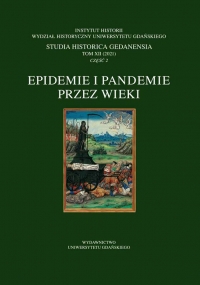„wie man sich mit Gottes hülffe vor der vergifftung bewaren”. (Nie)użyteczne zalecenia w zakresie ochrony przed zarazą w drukach gdańskich fizyków miejskich z XVI w.
“Wie man sich mit Gottes hülffe vor der vergifftung bewaren”. (No)useful
recommendations for protection against plague in the prints of Gdańsk (Danzig)
city physicians in the XVIth century
Author(s): Dariusz KaczorSubject(s): History, Cultural history, Social history
Published by: Wydawnictwo Uniwersytetu Jagiellońskiego
Keywords: Gdansk in the 16th century; city physicians; plagues; anti-epidemic prints
Summary/Abstract: The plagues that appeared cyclically and with a relatively high frequency were for the urban communities of the Middle Ages and the early modern era an experience almost permanently inscribed in everyday life. As part of the struggle against epidemics, in addition to administrative measures taken by the authorities, there began to appear from the end of the XVth century anti-epidemic compendia edited by city physicians (thus medical persons with university education) and intended for a wider audience; they became especially popular in the German cultural area during the XVIth century. It was no different in Gdańsk (Danzig), wherea high level of medicine, and the practice of employing as city physicians well-educated medical persons (from German and Protestant universities) by the city authorities, resulted in the publication of numerous prints of this type. In total, in the years 1508−1588 in Gdańsk (Danzig) seven compendiums of this type were published. They contained general recommendations for protection against plague based on Galen’s medical system relating to the so-called six unnatural things (res non naturales); they were part of a trend of popular medical literature containing “rules of health” (regimen sanitatis). The recommendations contained in the prints by Gdańsk (Danzig) city physicians of the XVIth century concerned, therefore, the preservation of unpolluted air in the city, taking sanitary measures, proper diet and physical condition, as well as “surgical” treatments (taking baths in a bathhouse, using laxatives, phlebotomy), and pharmacological care (they were also supervisors of the city pharmacy at that time). These recommendations, however, were not practical advice (contrary to their titles) that could be fully applied in a time of plague; rather, they represented the state of academic medical knowledge of that time and were only a manifestation of its popularization resulting from the medical personnel’s duties. A separate place was found for considerations on a kind of “medical theology”, related to the commonly shared view that the cause of the epidemic was divine anger interpreted as a punishment for sins. This was of particular importance in the confessional order (with a Lutheran dominant) that was taking shape in Gdańsk (Danzig) during the XVIth century.
Journal: Studia Historica Gedanensia
- Issue Year: 2/2021
- Issue No: 12
- Page Range: 131-172
- Page Count: 32
- Language: Polish

